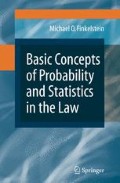Description
Description by summary is a basic function of statistical work. The essential tools are measures of central location – principally the mean, median, and mode – that locate in various ways the center of the data; measures of variability – most notably the variance and standard deviation – that express how widely data observations vary around their central value; and measures of correlation – particularly Pearson’s product–moment correlation coefficient – that describe the extent to which pairs of observations are linearly related. These are the building blocks on which the edifice of statistical reasoning is based. Let us look at their definitions in some detail.
Access this chapter
Tax calculation will be finalised at checkout
Purchases are for personal use only
Notes
- 1.
City of Los Angeles Dep’t of Water and Power v. Manhart, 435 U.S. 702, 708 (1978).
- 2.
Southern Pacific v. California State Board of Equalization, unpublished decision, discussed in D. Freedman, “The Mean Versus the Median: A Case Study in 4-R Act Litigation,” 3 Journal of Business & Economic Statistics 1 (1985).
- 3.
Clinchfield R.R. Company v. Lynch, 700 F.2d 126 (4th Cir. 1983).
- 4.
Heinrich v. Sweet, 308 F.3d 48, 62 (1st Cir. 2002), cert. denied, 539 U.S. 914 (2003).
- 5.
United States v. Gordon, 393 F.3d 1044 (9th Cir. 2004), cert. denied, 546 U.S. 957 (2005).
- 6.
42 U.S.C. § 1396r-4(b)(1)(A)(2006)(emphasis supplied).
- 7.
Garfield Medical Center v. Kimberly Belshe, 68 Cal. App. 4th 798 (Cal. App. 1998). I would think that the term “arithmetic mean” would not unambiguously point to an unweighted mean, as the court assumed in its argument from legislative history.
- 8.
Kelley ex rel. Michigan Dep’t of Natural Resources ex rel. v. FERC, 96 F.3d 1482 (D.C. Cir. 1996).
- 9.
EPA Review of fuel economy data, 40 C.F.R. § 600.008-01 (2005).
- 10.
U.S. Department of Commerce v. Montana, 503 U.S. 442, 463 (1992).
- 11.
P. Krugman, “For Richer: How the Permissive Capitalism of the Boom Destroyed American Equality,” The New York Times Magazine 62, 76 (October 20, 2002).
- 12.
Asher v. Baxter Int’1, Inc., 377 F.3d 727, 733 (7th Cir. 2004). One must say, however, that the court’s observation was no more than a speculation; it assumed there were other internal estimates and that the median of those estimates would have been sufficiently below the mean (which presumably was the projection that was reported) to suggest that the mean was unrepresentative.
- 13.
Exxon Shipping Co. v. Baker, 128 S. Ct. 2605 (2008).
- 14.
Id. at 2625.
- 15.
I am indebted to Professor Theodore Eisenberg for calling this to my attention.
- 16.
The FBI’s method of declaring a match is not technically correct, although it is close. See M.O. Finkelstein & B. Levin, “Compositional Analysis of Bullet Lead as Forenic Evidence,” 13 Journal of Law and Policy 119, 123 (2005). Under criticism for overstating the probative significance of its results, the FBI discontinued making such analyses in 2006.
- 17.
20 C.F.R. § 416.926a(e)(2)(iii); Briggs ex rel. Briggs v. Massanari, 248 F.3d 1235 (10th Cir. 2001).
- 18.
Qwest Communs. Int’l, Inc. v. FCC, 398 F.3d 1222, 1237 (10th Cir. 2005).
- 19.
Kirkpatrick v. Preisler, 394 U.S. 526, 531 (1969).
- 20.
Reynolds v. Sims, 377 U.S. 533, 579 (1964).
- 21.
531 U.S. 98 (2000)(per curiam).
- 22.
For further details on these computer studies, see M.O. Finkelstein & B. Levin, “Bush v. Gore: Two Neglected Lessons from a Statistical Perspective,” 44 Jurimetrics Journal 181 (2004).
- 23.
The variance of the sum of two positively correlated variables is equal to the sum of their variances plus two times the covariance between them.
- 24.
Conversely, a strong linear relation in a body of data may be diminished by outliers.
- 25.
San Antonio Independent School District v. Rodriguez, 411 U.S. 1 (1973).
- 26.
Id., 411 U.S. at 27.
- 27.
In re National Comm’n on Egg Nutrition, 88 F.T.C. 89 (1976), modified, 570 F.2d 157 (7th Cir. 1977), cert. denied, 439 U.S. 821 (1978).
- 28.
Davis v. Dallas, 487 F. Supp. 389, 393 (N.D. Tex. 1980).
- 29.
429 U.S. 190 (1976).
Author information
Authors and Affiliations
Corresponding author
Rights and permissions
Copyright information
© 2009 Springer Science+Business Media, LLC
About this chapter
Cite this chapter
Finkelstein, M.O. (2009). Descriptive Tools. In: Basic Concepts of Probability and Statistics in the Law. Springer, New York, NY. https://doi.org/10.1007/b105519_2
Download citation
DOI: https://doi.org/10.1007/b105519_2
Published:
Publisher Name: Springer, New York, NY
Print ISBN: 978-0-387-87500-2
Online ISBN: 978-0-387-87501-9
eBook Packages: Humanities, Social Sciences and LawLaw and Criminology (R0)

